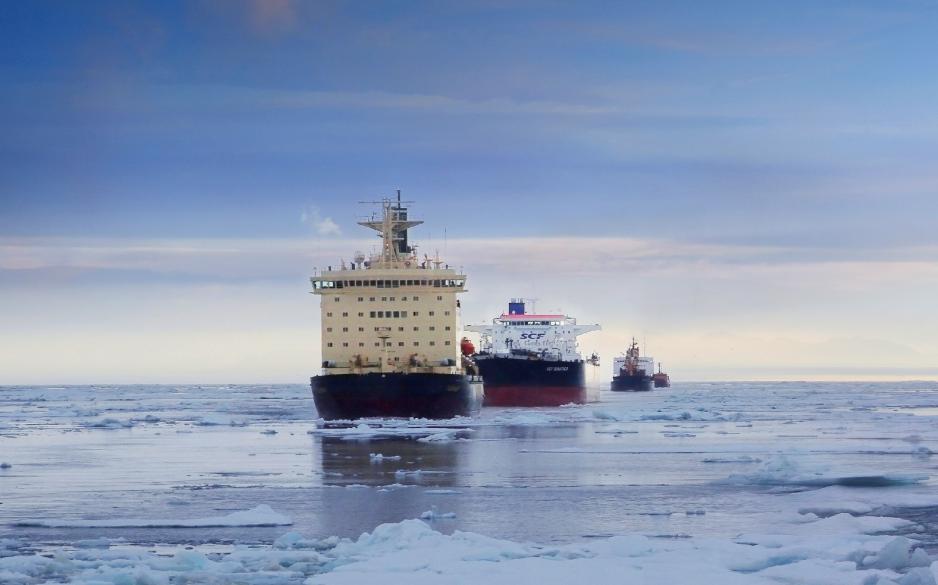What is There for the Arctic in the Updated Maritime Strategy of the Russian Federation?

Rosatomflot icebreaker escorting a convoy of vessels through the icy waters of the Northern Sea Route. (Courtesy of Rosatomflot)
Written by: Alexandra Middleton
The updated Maritime strategy of the Russian Federation for the period till 2030, published 30 August 2019, replaces an older version dating back to 2010. The decision to update the strategy was made after the adoption of Maritime Doctrine of the Russian Federation in 2015. The updated strategy reflects the current political and socio-economic situation in Russia and worldwide.
The strategy identifies challenges and priorities for development. Furthermore, the strategy provides strategic goals, tasks and measurement indicators and assigns responsibility for the execution, data collection and monitoring of strategy implementation. The document provides strategic goals for the period until 2020 and for the period 2021-2030.
About the author
Alexandra Middleton is an Assistant Professor in Financial Accounting at Oulu Business School, University of Oulu.
Her areas of expertise include sustainable business development, human capital, innovations and connectivity solutions in the Arctic.
She is a member of the European Financial Reporting Advisory Group (EFRAG) Task Force on Climate-Related reporting.
The strategy lists 43 challenges which constitute a significant increase compared to just 13 in its 2010 predecessor. Broadly, all challenges can be grouped under eight main themes: general development needs, protection of national interest, problems with obsolete equipment and infrastructure, international relations challenges (e.g., sanctions), deficiencies in regulatory and legal frameworks, people and skills issues, monitoring and R&D, and ecological issues. Notably, ecological challenges and needs to address ecological monitoring and impact assessment receive a boost as compared to the previous version. The openness and detailed description of the challenges is rather unprecedented, for instance, the strategy lists shortcomings in regulatory and legal frameworks defining conservation requirements of marine environment linked to the exploitation of natural resources.
What are the Arctic-specific challenges addressed by the strategy? International relations challenges are reflected in sanctions for certain Russian oil and gas companies to acquire foreign technology and equipment as well as foreign funding for the exploration and development of the Arctic sea resources. Secondly, the Arctic faces deficiencies in R&D such as the insufficient levels of navigational and hydrographic equipment, technological lagging in infrastructure and tools for sea bed exploration, insufficient level of monitoring due to obsolete equipment. Third, reliance on foreign solutions for satellite connectivity in the Arctic is considered problematic. Finally, the negative environmental impact of oil exploration and transportation in the Arctic zone receive separate attention. The strategy is open about the Arctic challenges sending a signal to stakeholders with, e.g., Arctic equipment, Arctic specific services and know-how to lean into this opportunity.

Alexandra Middleton, assistant Professor, PhD, Oulu Business School, University of Oulu
In the Arctic, the strategy prioritizes scientific expeditions for exploration of marine environment and resources. A strategically important goal is to increase the competitiveness of the Russian maritime transport on the global market with the Northern Sea Route being part of the solution.
Which indicators are used for the monitoring of strategy implementation in the Arctic? The new redaction of the strategy contains six Arctic-related indicators and three indicators specifically designated for the development of the Northern Sea Route. Worth noting is the increased number of ministries and governmental agencies responsible for meeting strategic goals and indicators’ monitoring from 2019. The responsibility is shared (dependent on the indicator) by The Ministry of Natural Resources and Environment of the Russian Federation, The Ministry of Industry and Trade, The Ministry of Science and Higher Education, The Federal Service for Hydrometeorology and Environmental Monitoring of Russia, Federal Agency on Mineral Resources, etc.
The indicators addressing the Arctic directly include: number of maritime scientific expeditions, number of expeditionary explorations of marine biological resources, number of stationary and floating scientific stations in the high latitudes of the Arctic Ocean, number of new in-service research scientific vessels, number of new multifunctional vessels for exploration of global sea bed mineral resources, and number of modernized maritime and hydrometeorological network units located in the Arctic zone of the Russian Federation.
Development of the NSR fulfils the goal of increasing competitiveness of Russian maritime transport on the maritime transportation market. Development is measured by volume of shipments (bln tonnes), volume of cargo transhipment in the seaports of the Arctic Ocean (bln tonnes), number of new in-service vessels of icebreaker (incl. nuclear) fleet. The responsibility for NSR development is shared by The Ministry of Transport, Federal Agency for Maritime and River Transportation and Rosatom State Atomiс Energy Corporation.
On a general note, increased attention to environmentally friendly solutions and ecological monitoring is reflected in ten indicators. These environmental indicators do not directly target the Arctic but are inclusive of it.
In summary, the strategy sets a strong stance for continuous improvement of the Russian global maritime position while paying attention to current deficiencies. The Arctic plays a crucial role in the Russian vision for maritime development. The strategy puts emphasis on research, science and resources exploration. In the case of the successful strategy execution, the Russian Arctic will benefit from improved regulatory and legislative base, new scientific and R&D infrastructure, human capital development, increased connectivity, and environmental protection efforts.
